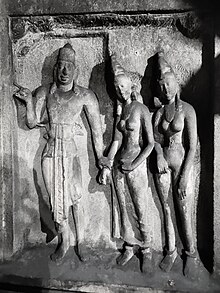| Mahendravarman I | |
|---|---|
 Sculpture of Mahendravarman I with his queens at Adivaraha Cave Temple. | |
| Pallava King | |
| Reign | 590–630 CE |
| Predecessor | Simhavishnu |
| Successor | Narasimhavarman I |
| Issue | Narasimhavarman I |
| House | Pallava |
| Father | Simhavishnu |
| Pallava Monarchs (200s–800s CE) | |
|---|---|
| Virakurcha | (??–??) |
| Vishnugopa I | (??–??) |
| Vishnugopa II | (??–??) |
| Simhavarman III | (??–??) |
| Simhavishnu | 575–600 |
| Mahendravarman I | 600–630 |
| Narasimhavarman I | 630–668 |
| Mahendravarman II | 668–670 |
| Paramesvaravarman I | 670–695 |
| Narasimhavarman II | 695–728 |
| Paramesvaravarman II | 728–731 |
| Nandivarman II | 731–795 |
| Dantivarman | 795–846 |
| Nandivarman III | 846–869 |
| Nrpatungavarman | 869–880 |
| Aparajitavarman | 880–897 |
Mahendravarman I (600–630 CE)[1][2] was a Pallava emperor who ruled over realm covering the southern portions of present-day Andhra region and northern regions of what forms present-day Tamil Nadu in India, in the early 7th century. He was a scholar, a painter, an architect and a musician. He was the son of Simhavishnu, who defeated the Kalabhras and re-established the Pallava kingdom.
During his reign, the Chalukya monarch Pulakeshin II attacked the Pallava realm. The Pallavas fought a series of wars in the northern Vengi region, before Mahendra-varman decimated his chief enemies at Pullalur (according to Pallava grants at Kuram, Kasakudi and Tadantottam). Although Mahendra-varman saved his capital, he lost the northern provinces to Pulakeshin.[3] Tamil literature flourished under his rule, with the rise in popularity of Tevaram written by Appar and Sambandhar. Mahendravarman I was the author of the play Mattavilasa Prahasana which is a Sanskrit satire. During his period "Bhagwatajjukam", another satire (prahasan), was written by Bodhayan. King Mahendravarman mentioned this on a stone inscription in Mamandur along with his own Mattavilas Prahasan.[4]
Mahendra-varman was succeeded to the throne by his more famous son Narasimhavarman I in 630 CE.[1] who defeated Pulakeshin II of Chalukya dynasty and ransacked the Chalukyan capital city of Vatapi (also known as Badami).
- ^ a b Hall, John Whitney, ed. (2005) [1988]. "India". History of the World: Earliest Times to the Present Day. John Grayson Kirk. 455 Somerset Avenue, North Dighton, MA 02764, USA: World Publications Group. p. 246. ISBN 1-57215-421-7.
{{cite book}}: CS1 maint: location (link) - ^ Seventeen, Volume (1885). Indian kingdoms by royal asiatic society of great britain. Royal asiatic society of great Britain.
- ^ Sastri 2008, p. 136
- ^ Bodhayan's Bhagwatajjukam edited by Veturi Prabhakara Sastri, Manmanjari Publications, Hyderabad, 2nd edition 1986, for more information Veturi Prabhakara Sastri Memorial Trust, 2-2-18/15/18/D/1, Bagh Amberpet, Hyderabad 500013